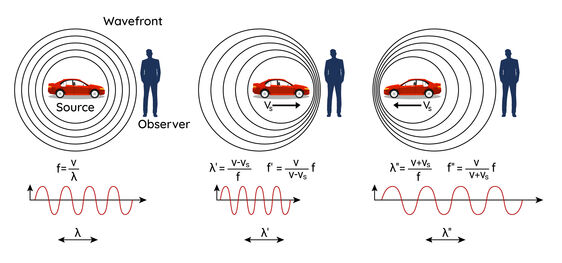The Doppler effect: a comprehensive insight
The Doppler Effect, a fascinating phenomenon that has changed the fundamentals of wave motion, influences many aspects of our modern science and technology.

The Doppler Effect, a fascinating phenomenon that has changed the fundamentals of wave motion, influences many aspects of our modern science and technology.
The Doppler effect, named after the Austrian physicist Christian Doppler who described this phenomenon in 1842, is a ubiquitous principle in physics that describes the change in wave frequency for an observer moving relative to the source of that wave. This phenomenon occurs in both sound and light waves and has a variety of practical applications in science and technology.
To understand the Doppler effect, imagine that a sound source, like a loud siren, is moving toward or away from you. As the source approaches, the sound waves appear to be compressed, resulting in a higher frequency, while as they move away, they appear to stretch, resulting in a lower frequency. This phenomenon is also known as the acoustic Doppler effect and is easy to observe, for example when an ambulance drives past you with its siren on.

Similar effects can be observed with light, known as the optical Doppler effect. When a light source moves towards an observer, the light shifts to bluer wavelengths (blue shift), while it shifts to redder wavelengths (red shift) as the light source moves away from the observer. This effect is of crucial importance in astronomy in order to understand the movement of stars and galaxies in the universe.
The Doppler effect is not only a fascinating scientific phenomenon, but also fundamental to numerous technological applications. In medicine, Doppler sonography allows doctors to monitor blood flow and heart function, which is crucial for the diagnosis of various cardiovascular diseases. In meteorology, the Doppler effect is used to determine wind speeds and directions, which contributes to more accurate weather forecasting and storm warnings.
One of the best-known applications of the Doppler effect is speed measurement. This is used by the traffic police, among others, where radar devices use the Doppler effect to measure the speed of vehicles. These devices emit electromagnetic waves that are reflected by the vehicles. The speed of the vehicle can be precisely calculated from the frequency shift of the returning waves.
Despite its versatility, the use of the Doppler effect also has limitations. Measurements can be affected by various factors such as environmental conditions, angular deviations between the direction of movement of the source and the orientation of the measuring device or interference from other signals. These factors must be carefully controlled to ensure accurate results.

In vibrometry, the Doppler effect is used to measure subtle vibrations and movements of objects. In laser Doppler vibrometry (LDV) in particular, this effect is exploited by directing a laser beam at an object and analyzing the frequency changes of the reflected light. This is expressed by the formula ΔfD = 2v/λc. This method is widely used in various applications such as materials science, structural monitoring and production quality control.
To summarize, laser Doppler vibrometry (LDV) is an outstanding application of the Doppler effect that has become indispensable in a variety of industries and research fields due to its accuracy and non-invasiveness. LDV enables the precise measurement of surface vibrations without physical contact with the object, which is particularly invaluable in sensitive applications such as materials science, aerospace and construction monitoring. Through the continuous development and improvement of LDV technology, the possibilities for researching dynamic processes and quality control in production are constantly expanding, allowing the Doppler effect to continue to play a central role in scientific and technological innovation.
Further topics on basics & measurement technology